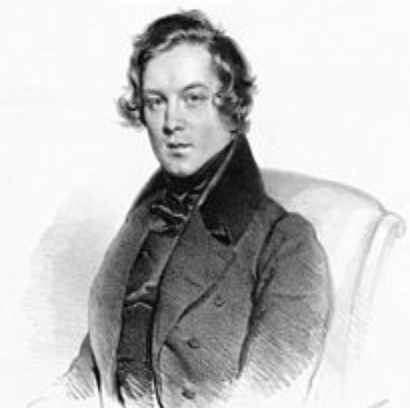
Robert Schumann was born on June 8, 1810 in Zwickau, Saxony (now Germany). He began composing music before age 7, and by age 14, had written an essay on the aesthetics of music, in a volume titled “Portraits of Famous Men.” In 1829, Robert undertook the study of law in Heidelberg.
The following year, he was inspired by the famous Italian violinist and composer Niccolò Paganini, whom he heard in Frankfurt, to undertake piano lessons in the hope of participating in concert performances. However, an injury to his right hand terminated this dream and he turned to composition.
In 1832, the first movement of Schumann’s Symphony in G minor was performed at a concert given by Clara Wieck, who was then just 13 years old. On this occasion, Robert’s mother said to Clara, “You must marry my Robert one day.”
In 1833, traumatized by the deaths of his brother Julius and his sister-in-law Rosalie, Schumann attempted suicide–providing a hint of cognitive disturbances that would visit him in later life. However, as time passed, he recovered his zest for living and in 1835, declared his love for 15-year-old Clara Wieck. In 1837, he sought her father’s consent to a marriage, but her father refused, ridiculing his daughter’s wish to ‘throw herself away on a penniless composer’. However, by 1840 Robert Schumann had completed The Fantasia in C, Kinderszenen, Träumerei no.7 and Kreisleriana, that were later hailed as some of his greatest works.
In 1840, a long legal battle with Clara’s father was resolved when Clara was old enough to marry without her father’s consent and the couple was married. Despite his remarkable achievements, as a composer, Schumann’s celebrity remained in the shadow of Clara’s international acclaim as a supreme pianist.
In 1841, Schumann wrote his famous “Spring Symphony” and followed this in 1842 with the Piano Quintet in E flat, and and three string quartets. In the years that followed he began to suffer from persistent “nervous prostration”, characterized by fits of shivering, an apprehension of death, and the perpetual sound of the note A5 ringing in his ears–a state of mind reflected in his Symphony in C.
At the beginning of the next decade, Schumann completed his Symphony No. 3 “Rhenish” and revised a work that was eventually published as his fourth symphony. Then, on 30 September 1853, 20-year-old Johannes Brahms arrived at the Schumann’s home carrying a letter of introduction from the violinist Joseph Joachim Brahms impressed Clara and Robert with his musical compositions and resided with them for several weeks, becoming a close family friend. Schumann hailed Brahms as an heir to the legacy of Beethoven while stating, “The principal mark of genius is not perfection, but originality.”
On 27 February 1854, Robert Schumann threw himself from a bridge into the Rhine River, but was rescued by some boatmen and taken home. He subsequently requested residence in an asylum for the insane and remained there until his death on 29 July 1856.
